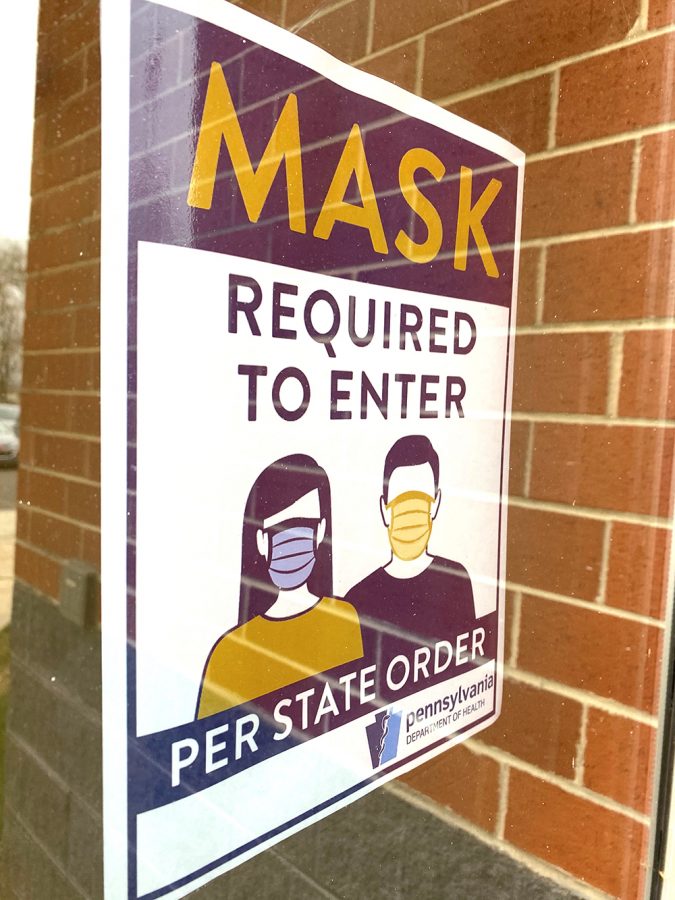Different Mask Styles: What’s Right For You?
A sign is displayed at the 10-12 Center encouraging students to wear masks prior to entering the building.
December 23, 2020
Due to the raging global pandemic, most places have enacted a mask mandate.
But, what exactly does that mean?
It just means you must be wearing a “face covering.” The US Center for Disease Control (CDC) defines a face covering as, “any of various devices that cover the mouth and nose and are used to prevent inhalation of dangerous substances.”
This definition is very broad, but a few styles of masks have stood out as people develop strategies to combat the virus. Regardless of which mask you choose, the CDC emphasizes their importance in combating COVID-19.
“We are not defenseless against COVID-19,” said CDC Director Dr. Robert R. Redfield in a press release this past summer. “Cloth face coverings are one of the most powerful weapons we have to slow and stop the spread of the virus – particularly when used universally within a community setting. All Americans have a responsibility to protect themselves, their families, and their communities.”
N95 masks are the most effective at protection — filtering out up to 95 percent of particles in the air — but should be reserved for medical workers, and the CDC urges people in possession of such masks to donate them to medical facilities.
The most common mask is the paper surgical mask — the rectangular, disposable type. These surgical masks are available at most grocery and department stories by now, but some in stores are not necessarily considered medical grade. A study from the National Institute for Occupational Safety and Health found that a medical-grade surgical mask blocked 59% of respiratory aerosols from a cough.
Homemade masks made from quilting fabrics are also a common choice. While very popular, a single layer mask only blocks 35% particles, and a multiple layer mask blocks around 45% according to a report in the British Medical Journal. A Yale study found that a three-ply cotton cloth face mask blocked 51% of particles.
If you want to make a mask, May Chu, an epidemiologist at the Colorado School of Public Health, recommends adding a filter pocket. Filters such as polypropylene, and even folded up tissues, can improve the effectiveness of a homemade mask. The filter should be replaced after each wear.
Researchers have stated that masks with exhalation valves or vents should not be worn to prevent the spread COVID-19 to others. These vents allow unfiltered air to exit the mask, easily spreading particles.
According to Johns Hopkins Medicine, cloth masks should ideally be made of tight-knit 100% cotton and have at least three layers. So, store bought masks are a good option, just double check the description and fiber content before purchasing.
Neck gaiters and balaclavas have become very popular amongst outdoors enthusiasts and athletes. In essence, they are tubes of fabric that can be pulled up around your face and neck. While they are convenient and comfortable, multiple studies have shown that some synthetic fabrics and fleeces, used to make most athletic gear, convert droplets into aerosols, doing more harm than good.
Of notable mention are T-shirt masks, face shields, and bandanas. T-shirt masks are very comfortable and easy to make. However, according to a 2013 study published in Disaster Medicine and Public Health Preparedness, T-shirt masks are one-third as effective as disposable surgical masks. You can increase their effectiveness by adding multiple layers. Face shields are not recommended as they are still undergoing testing. Bandanas reduce the spray of particles only marginally, so it is not suggested that bandanas are your default mask.
As we start transitioning back into school and leaving our houses on a regular basis, it is critical that everyone has masks available. It is also important that everyone wear their masks correctly. A properly worn mask covers your mouth and nose and fits snugly, without gaps or holes on the sides. More information about making, wearing, and cleaning masks can be found on the CDC website.
Different masks will work for different people, but one thing is always true. When you wear a mask, you can save a life.

